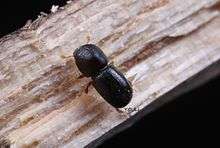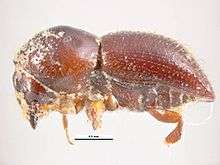Euwallacea fornicatus
Euwallacea fornicatus is a species complex consisting of three cryptic species of ambrosia beetles (Coleoptera: Curculionidae: Scolytinae: Xyleborini), known as an invasive species in California, Israel and South Africa.[1] As the rest of the ambrosia beetles, E. fornicatus larvae and adults feed on a symbiotic fungus carried in a specific structure called mycangium. In E. fornicatus, the mycangium is located in the mandible. The combination of massive numbers of beetles with the symbiotic fungus kill trees, even though the fungus alone is a weak pathogen.[2]
| Euwallacea fornicatus | |
|---|---|
 | |
| Adult female of E. fornicatus | |
| Scientific classification | |
| Kingdom: | |
| Phylum: | |
| Class: | |
| Order: | |
| Family: | |
| Subfamily: | |
| Genus: | Euwallacea |
| Species: | E. fornicatus |
| Binomial name | |
| Euwallacea fornicatus (Eichhoff, 1868) | |
| species in the complex | |
|
Tea shot hole borer | |
Euwallacea fornicatus breeds in various live hosts and is considered a severe pest of several economically important plants, such as: tea (Camellia sinensis), avocado (Persea americana), citrus (Citrus spp.) and cacao (Theobroma cacao).[3]
Identification
Adult

Adult females are range between 1.9-2.5 mm long. They are bulky, dark brown or black and the frontal edge of the pronotum has a row of saw-like projections.[4] Moreover, specimens have erect setae organized in rows in the elytral declivity with a costa in the posterolateral edge. As many other ambrosia beetles, males are significantly smaller, with non-functional wings.
Larvae
Larvae are similar to all other larvae in the family Curculionidae; legless, c-shaped and a sclerotized head capsule.
History of expansion
The tea shot hole borer has been known to cause devastating damage to tea (Camellia sinensis) in at least ten different countries,[4] including India and Sri Lanka where it is a major economic pest.[5] In 2009, specimens matching the description for E. fornicatus were introduced into Israel, where they were documented as vectors of a new fungal plant pathogen in avocado trees. In 2012, similar fungal disease was recorded in avocado trees in California (CA).[3] Since 2007, specimens of E. fornicatus have been documented in Florida on avocado trees. However, it is not considered a health threat because no disease is expressed.[6]
Taxonomy
Even though several taxa were synonymized under the name E. fornicatus due to morphological similarity, some of the clades are different in terms of economic severity. Euwallacea fornicatus is considered a species complex, with several clades that occur in separate regions of Southeast Asia and develop in different hosts.[2] Phylogenetic work using the DNA mitochondrial gene COI suggested that there are three major clades within the species E. fornicatus, supporting the idea of at least three different species with phylogeographic boundaries within the species complex.[7]
The first clade proposed, E. fornicatus sensu stricto (commonly called the tea shot hole borer), is originally from southern Southeast Asia and was introduced into Hawaii and Florida. A second clade, the Kuroshio shot hole borer, is believed to have originated in the Pacific Islands and has since been introduced into San Diego county, California. The third clade is thought to originate from a more northern range in Southeast Asia and to have since been introduced into Los Angeles, California, Israel and South Africa.[8] This last clade has been given the common name polyphagous shot hole borer in reference to the very broad host range. It has been severely affecting avocado trees in association with several Fusarium species.[9] Its impact has impacted many trees in San Diego County, as far south as the Tijuana River Valley Regional Park.[10] Multiple populations of the E. fornicatus complex have been introduced throughout the world, causing different damage in each region where they have been recently introduced.
Etymology
See Wallacea, region of Indonesian islands named after the naturalist Alfred Russel Wallace.
Management
The most recommended management strategies include sanitation of infected hosts and avoiding the spread of infected material. Chemical control can be considered in hosts which are not part of human consumption and some attempts of biological control have been made with little success. Moreover, resistant or tolerant varieties are considered an important aspect of the integrated pest management for this pest.[11]
See also
- Ambrosia Beetle
- Forest pathology
- Laurel wilt disease
- Xyleborus glabratus
References
- Paap T, de Beer ZW, Migliorini D, Nel WJ, Wingfield MJ (March 2018). "The polyphagous shot hole borer (PSHB) and its fungal symbiont Fusarium euwallaceae: a new invasion in South Africa" (PDF). Australasian Plant Pathology. 47 (2): 231–237. doi:10.1007/s13313-018-0545-0.
- Smith, S; Hulcr, J (2015). Vega & Hofstetter (ed.). Bark Beetles: Biology and Ecology of Native and Invasive Species. San Diego: Elsevier. pp. 495–532.
- Eskalen, Akif; Stouthamer, Richard; Lynch, Shannon Colleen; Rugman-Jones, Paul F.; Twizeyimana, Mathias; Gonzalez, Alex; Thibault, Tim (2013-01-29). "Host Range of Fusarium Dieback and Its Ambrosia Beetle (Coleoptera: Scolytinae) Vector in Southern California". Plant Disease. 97 (7): 938–951. doi:10.1094/PDIS-11-12-1026-RE. ISSN 0191-2917.
- Hulcr, You Li, Andrea Lucky, and Jiri (2015-07-08). "Tea Shot-Hole Borer Euwallacea fornicatus (Eichhoff, 1868) (Insecta: Coleoptera: Curculionidae: Scolytinae)". edis.ifas.ufl.edu. Retrieved 2017-02-25.
- Danthanarayana W. 1968. The distribution and host range of the shot-hole borer (Xyleborus fornicatus Eichh.), Tea Quarterly, 39:61-69.
- Carrillo, Daniel; Duncan, Rita E.; Peña, Jorge E. (2012-09-01). "Ambrosia Beetles (Coleoptera: Curculionidae: Scolytinae) that Breed in Avocado Wood in Florida". Florida Entomologist. 95 (3): 573–579. doi:10.1653/024.095.0306. ISSN 0015-4040.
- Stouthamer, Richard; Rugman-Jones, Paul; Thu, Pham Q.; Eskalen, Akif; Thibault, Tim; Hulcr, Jiri; Wang, Liang-Jong; Jordal, Bjarte H.; Chen, Chi-Yu (2017-02-01). "Tracing the origin of a cryptic invader: phylogeography of the Euwallacea fornicatus (Coleoptera: Curculionidae: Scolytinae) species complex". Agricultural and Forest Entomology. 19 (4): 366–375. doi:10.1111/afe.12215. ISSN 1461-9563.
- de Beer, Wilhelm. "A tiny beetle and its deadly fungus is threatening South Africa's trees". ENCA. The Conversation. Retrieved 2 March 2018.
- Kasson, M.T.; O’Donnell, K.; Rooney, A.; Sink, S.; Ploetz, R.; Ploetz, J.N.; et al., 2013. An inordinate fondness for Fusarium: phylogenetic diversity of fusaria cultivated by ambrosia beetles in the genus Euwallacea on avocado and other plant hosts. Fungal Genetic Biology 56, 147–157.
- Tjoa, May (25 July 2018). "Tiny Beetle Kills Trees, Ups Fire Risk in San Diego". KNSD. San Diego. Retrieved 2 August 2018.
- Walgama, Ravindra S. (2012-12-01). "Ecology and Integrated Pest Management of Xyleborus fornicatus (Coleoptera: Scolytidae) in Sri Lanka". Journal of Integrated Pest Management. 3 (4): 1–8. doi:10.1603/ipm11031.